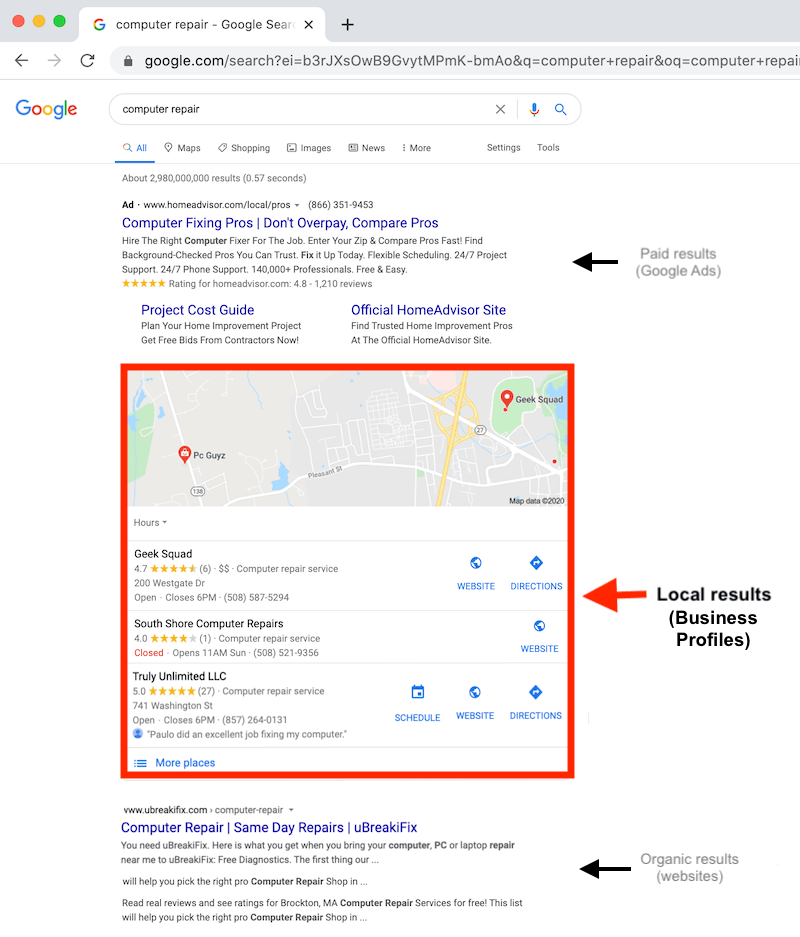Have you ever searched for “best coffee shop near me” while craving caffeine?
Then, you’ll see a list of cafes nearest to your location. If you own a business, you should also work hard to ensure that it ranks at the top in local searches.
But how can you do that?
Traditional SEO strategies will not be fruitful for this. That’s why you should opt for a local SEO audit. It helps you analyze your business’s online presence, identify hidden gaps, and optimize your business for better visibility.
So, if you run a restaurant, a dental clinic, or a home services company, local SEO will bring more customers to your door. This guide will teach you everything you need to know about local SEO audits.
So, let’s dive in.
What Is Local SEO & Why Does It Matter?
Local SEO refers to optimizing the website and enhancing its online presence. Thus increasing local searches. Some of the common searches for this are:
- Bakery near me
- Best plumber in Florida
- Hair salon in Birmingham

Source – wordstream
According to the latest reports, 4 out of 5 consumers search with local intent. This means there are lots of opportunities for local businesses to increase their foot traffic.
By nailing your local SEO strategy, you can grow your business. Do you know how?
Top ranks in local searches → More people see your business profile → Increase in customers → Business growth.
Step-by-Step Local SEO Audit
Now that you know about local SEO, it’s time to dive deeper. Local SEO consists of several steps, each focusing on enhancing online presence, which leads to an overall boost in business.
That’s why we have broken down a simple and actionable process to perform an SEO audit.
Step 1: Check Your Google Business Profile

Source – semrush
The most important ranking factor in local SEO is your Google Business Profile (GBP). You need to understand how Google shows this profile to people.
Let’s assume you’re looking for salon services. When you type this keyword, the Google algorithm will start working. It’ll shortlist all the salons with optimized profiles and show you relevant ones.
To audit your GBP, you first need to check your Business Name, Address, and Phone Number (NAP). Even minor details like St. vs. Streets have a high impact on rankings.
Choose the right categories, for example, Italian Restaurants instead of just Restaurants. Update your business hours to ensure your customers don’t face any issues.
Have you added high-quality images?
If not, you need to do it right now. Businesses with images get 42% more requests for directions and 35% more clicks to their websites.
Pro Tip: Use location-specific keywords in your business description, like we are a family-owned bakery in NYC.
Step 2: Audit Your Local Citations
Local citations are mentions of your business across different directories. Consistent citations can boost business credibility and local rankings. Some of these directories are:
- Yelp
- Bing Places
- Apple Maps
- Yellow Pages
Audit your citations to ensure NAP consistency. Check for duplicate listings, as they can harm your rankings. Then, go one step ahead and list your business on all the directories mentioned above.
You don’t have to do everything manually. You can use tools like Moz Local, BrightLocal, or Whitespark. They automate citation tracking and make corrections.
Step 3: Analyze the Website’s On-Page SEO
Your website should be optimized to appear in SERPs. The first thing you need to do is target location-specific keywords.
Don’t use keywords like Best Plumber.
Instead, use the keyword Best Plumber in the UK.
More than 50% of local searches are from mobile. Ensure your website is mobile-friendly and responsive.
If you have multiple locations, create separate pages for each. Use schema markup so search engines can understand your business details and show them to relevant people.
Another important thing is optimizing Title Tags and meta descriptions. If you’re running a coffee shop, here’s how to optimize the content.
- Title Tag: Best Coffee Shop in NYC – Freshly Brewed Coffee & Pastries
- Meta Description: Visit our award-winning coffee shop in NYC. Enjoy fresh, locally roasted coffee and homemade pastries. Open daily.
Step 4: Keep Close Eyes On Your Online Reviews
Do you know what impacts a customer’s purchasing decision?
It’s what other people say about you, aka customer reviews. If they are positive, Google will also push your profile to the top of search results.
An interesting strategy is to offer incentives like discounts or freebies for leaving honest feedback. Use email or SMS campaigns to request reviews from satisfied customers.
Never buy fake reviews; they do more harm than good. Google has penalized many businesses because of this practice.
Step 5: Perform a Competitor Analysis
By doing this, you can gain a clear competitive edge. It helps businesses understand what they are doing right and how to improve. But how can you do competitor analysis?
Just follow these simple steps.
- Quickly perform a Google search and list all the companies that rank higher than you.
- Check the strategy and tactics they are using.
- Note down categories, keywords, and images they use in their GMB profile.
- Analyze customer sentiments by checking their reviews.
- Use Ahrefs to identify their backlinks and check if you can replicate them.
Best Tools for Local SEO Auditing
Manually conducting local SEO audits can be draining. Here are some tools that can make this process easier.
| Tool | Purpose | Key Features |
| Google Business Profile (GBP) | Manage and track your local listing | Update business details, respond to reviews, track performance |
| Moz Local | Track and fix citation inconsistencies | Finds duplicate listings, ensures NAP consistency, and updates citations automatically |
| Ahrefs | Analyze backlinks and keyword rankings | Find competitor backlinks, track keyword rankings, audit website SEO |
| Google Search Console | Identify technical SEO issues | Monitor website health, detect errors, analyze search performance |
| Semrush | Track rankings and competitor performance | Keyword research, competitor analysis, site audit tools |
Why Should You Perform a Local SEO Audit?
Customers will see the Google Local Pack whenever they search for your service. It shows the top 3 businesses in the local search results.
So what if your competitors appear in it?
It will immediately decrease your chances of acquiring customers. Local SEO increases local customers having a direct impact on foot traffic.
Don’t rely on just a bunch of keywords. Do research and identify keyword opportunities to outperform your competitors. Often, ranking may decrease due to technical issues. So, fix all technical issues quickly and focus on providing a mobile-friendly experience to users.
Local SEO Audit Checklist
Still confused about elements of local SEO?
Here’s a quick local SEO audit checklist to identify if you’re moving in the right direction.
- Analyze your Google Business Profile
- Check (and optimize) your local citations
- Review on-page SEO elements
- Assess your online reviews
- Perform a competitor analysis
To Sum Up
A well-optimized local SEO strategy can enhance your business. Ensure that you’re conducting regular SEO audits. This will help you stay ahead of the competition and attract more local customers.
But it’s essential to implement it correctly. Only then will it boost your local search rankings.
However, SEO is an evolving field, and staying up-to-date with every latest trend can be draining. So what should you do?
Brick Mortar Digital is here to offer you expert guidance. There is no need to do everything on your own. Let us handle your website growth so you can focus on running your business.
For further details, get in touch with us today.




